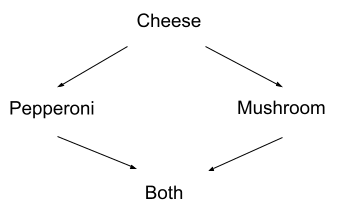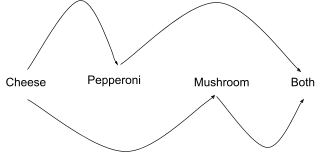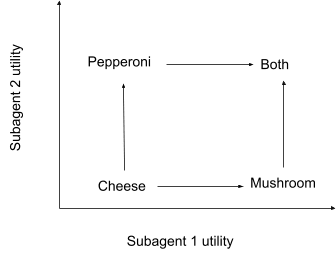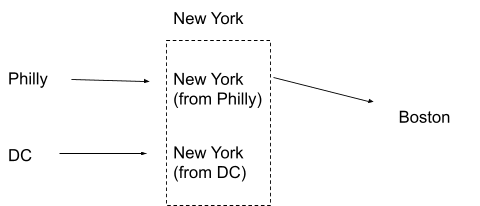The justification for modelling real-world systems as “agents” - i.e. choosing actions to maximize some utility function - usually rests on various coherence theorems. They say things like “either the system’s behavior maximizes some utility function, or it is throwing away resources” or “either the system’s behavior maximizes some utility function, or it can be exploited” or things like that. Different theorems use slightly different assumptions and prove slightly different things, e.g. deterministic vs probabilistic utility function, unique vs non-unique utility function, whether the agent can ignore a possible action, etc.
One theme in these theorems is how they handle “incomplete preferences”: situations where an agent does not prefer one world-state over another. For instance, imagine an agent which prefers pepperoni over mushroom pizza when it has pepperoni, but mushroom over pepperoni when it has mushroom; it’s simply never willing to trade in either direction. There’s nothing inherently “wrong” with this; the agent is not necessarily executing a dominated strategy, cannot necessarily be exploited, or any of the other bad things we associate with inconsistent preferences. But the preferences can’t be described by a utility function over pizza toppings.
In this post, we’ll see that these kinds of preferences are very naturally described using subagents. In particular, when preferences are allowed to be path-dependent, subagents are important for representing consistent preferences. This gives a theoretical grounding for multi-agent models of human cognition.
Preference Representation and Weak Utility
Let’s expand our pizza example. We’ll consider an agent who:
- Prefers pepperoni, mushroom, or both over plain cheese pizza
- Prefers both over pepperoni or mushroom alone
- Does not have a stable preference between mushroom and pepperoni - they prefer whichever they currently have
We can represent this using a directed graph:

The arrows show preference: our agent prefers B over A if (and only if) there is a directed path from A to B along the arrows. There is no path from pepperoni to mushroom or from mushroom to pepperoni, so the agent has no preference between them. In this case, we’re interpreting “no preference” as “agent prefers to keep whatever they have already”. Note that this is NOT the same as “the agent is indifferent”, in which case the agent is willing to switch back and forth between the two options as long as the switch doesn’t cost anything.
Key point: there is no cycle in this graph. If the agent’s preferences are cyclic, that’s when they provably throw away resources, paying to go in circles. As long as the preferences are acyclic, we call them “consistent”.
Now, at this point we can still define a “weak” utility function by ignoring the “missing” preference between pepperoni and mushroom. Here’s the idea: a normal utility function says “the agent always prefers the option with higher utility”. A weak utility function says: “if the agent has a preference, then they always prefer the option with higher utility”. The missing preference means we can’t build a normal utility function, but we can still build a weak utility function. Here’s how: since our graph has no cycles, we can always order the nodes so that the arrows only go forward along the sorted nodes - a technique called topological sorting. Each node’s position in the topological sort order is its utility. A small tweak to this method also handles indifference.

(Note: I’m using the term “weak utility” here because it seems natural; I don’t know of any standard term for this in the literature. Most people don’t distinguish between these two interpretations of utility.)
When preferences are incomplete, there are multiple possible weak utility functions. For instance, in our example, the topological sort order shown above gives pepperoni utility 1 and mushroom utility 2. But we could just as easily swap them!
Preference By Committee
The problem with the weak utility approach is that it treats the preference between pepperoni and mushroom as unknown - depending on which possible utility we pick, it could go either way. It’s pretending that there’s some hidden preference there which we simply don’t know. But there are real systems where the preference is not merely unknown, but a real preference to stay in the current state.
For example, maybe our pizza-agent is actually a committee which must unanimously agree to any proposed change. One member prefers pepperoni to no pepperoni, regardless of mushrooms; the other prefers mushrooms to no mushrooms, regardless of pepperoni. This committee is not exploitable and does not throw away resources, nor does it have any hidden preference between pepperoni and mushrooms. Viewed as a black box, its “true” preference between pepperoni and mushrooms is to keep whichever it currently has.
In fact, it turns out that we can represent any consistent preferences by a committee requiring unanimous agreement.
The key idea here is called order dimension. We want to take our directed acyclic graph of preferences, and stick it into a multidimensional space so that there is an arrow from A to B if-and-only-if B is higher along all dimensions. Each dimension represents the utility of one subagent on the committee; that subagent approves a change only if the change does not decrease the subagent’s utility. In order for the whole committee to approve a change, the trade must increase (or leave unchanged) the utilities of all subagents. The minimum number of agents required to make this work - the minimum number of dimensions required - is the order dimension of the graph.
For instance, our pizza example has order dimension 2. We can draw it in a 2-dimensional space like this:

Note that, if there are infinitely many possibilities, then the order dimension can be infinite - we may need infinitely many agents to represent some preferences. But as long as the possibilities are finite, the order dimension will be as well.
Path-Dependence
So far, we’ve interpreted “missing” preferences as “agent prefers to stay in current state”. One important reason for that interpretation is that it’s exactly what we need in order to handle path-dependent preferences.
In practice, path-dependent preferences mostly matter for systems with “hidden state”: internal variables which can change in response to the system’s choices. A great example of this is financial markets: they’re the ur-example of efficiency and inexploitability, yet it turns out that a market does not have a utility function in general (economists call this “nonexistence of a representative agent”). The reason is that the distribution of wealth across the market’s agents functions as an internal hidden variable. Depending on what path the market follows, different internal agents end up with different amounts of wealth, and the market as a whole will hold different portfolios as a result - even if the externally-visible variables, i.e. prices, end up the same.
Most path-dependence results from some hidden state directly, but even if we don’t know the hidden state, we can always add hidden state in order to model path-dependence. Whenever future preferences differ based on how the system reached the current state, we just split the state into two states - one for each possibility. Then we repeat, until we have a full set of states with path-independent preferences between them. These new states are “full” states of the system; from outside, some of them look the same.
An example: suppose I prefer New York to Boston if I just came from DC, but Boston to New York if I just came from Philadelphia.

We can represent that with hidden state:

We now have two separate hidden internal nodes, which both correspond to the same externally-visible state “New York”.
Now the key piece: there is no way to get to the “New York (from Philly)” node directly from the “New York (from DC)” node. The agent does not, and cannot, have a preference between these two nodes. Analogously, a market cannot have a preference between two different wealth distributions - the subagents who comprise a market will never spontaneously decide to redistribute their wealth amongst themselves. They always “prefer” (or “decide”) to stay in whatever state they’re currently in.
This is why we need to understand incomplete preferences in order to handle path-dependent preferences: hidden state creates situations where the agent “prefers” to stay in whatever state they’re in.
Now we can easily model the system using subagents exactly as we did for incomplete preferences. We have a directed preference graph between full states (including hidden state), it needs to be acyclic to avoid throwing away resources, so we can find a set of subagents to represent the preferences. In the case of a market, this is just the subagents which comprise the market: they’ll take a trade if it does not decrease the utility of any subagent. (Note, however, that the same externally-visible trade can correspond to multiple possible internal state changes; the subagents will take the trade if any of the possible internal state changes are non-utility-decreasing for all of them. For a market, this means they can trade amongst themselves in response to the external trade in order to make everyone happy.)
Applications & Speculations
We’ve just argued that a system with consistent preferences can be modelled as a committee of utility-maximizing agents. How does this change our interpretation and predictions of the world?
First and foremost: the subagents argument is a generalization of the standard acyclic preferences argument. Anytime we might want to use the acyclic preferences argument, but there’s no reason for the system to be path-independent, we can apply the subagents argument instead. In practice, we usually expect systems to be efficient/inexploitable because of some selection pressure (evolution, market competition, etc) - and that selection pressure usually doesn’t care about path dependence in and of itself.
Main takeaway: pretty much anywhere we’d use an agent with a utility function to model something, we can apply the subagents argument and use a committee of agents with utility functions instead. In particular, this is a good replacement for "weak" utility functions.
Humans are a particularly interesting example. We’d normally use the acyclic preferences argument (among other arguments) to argue that humans approximate utility-maximizers in most situations. But there’s no particular reason to assume path-independence; indeed, human behavior looks highly path-dependent. So, apply the subagents argument. Hypothesis: human behavior approximates the choices of a committee of utility-maximizing agents in most situations.
Sound familiar? The subagents argument offers a theoretical basis for the idea that humans have lots of internal subagents, with competing wants and needs, all constantly negotiating with each other to decide on externally-visible behavior.
In principle, we could test this hypothesis more rigorously. Lots of people think of AI “learning what humans want” by asking questions or offering choices or running simulations. Personally, I picture an AI taking in a scan of a full human connectome, then directly calculating the embedded preferences. Someday, this will be possible. When the AI solves those equations, do we expect it to find a single generic optimizer embedded in the system, approximately optimizing some “utility”? Or do we expect to find a bunch of separate generic optimizers, approximately optimizing several different “utilities”, and negotiating with each other? Probably neither picture is complete yet, but I’d bet the second is much closer to reality.
Conclusion
Let’s recap:
- The acyclic preferences argument is the easiest entry point for efficiency/inexploitability-implies-utility-maximization theorems, but it doesn’t handle lots of important things, including path dependence.
- Markets, for example, are efficient/inexploitable but can’t be represented by a utility function. They have hidden internal state - the distribution of wealth over agents - which makes their preferences path-dependent.
- The subagents argument says that any system with deterministic, efficient/inexploitable preferences can be represented by a committee of utility-maximizing agents - even if the system has path-dependent or incomplete preferences.
- That means we can substitute committees in many places where we currently use utilities. For instance, it offers a theoretical foundation for the idea that human behavior is described by many negotiating subagents.
One big piece which we haven’t touched at all is uncertainty. An obvious generalization of the subagents argument is that, once we add uncertainty (and a notion of efficiency/inexploitability which accounts for it), an efficient/inexploitable path-dependent system can be represented by a committee of Bayesian utility maximizers. I haven’t even started to tackle that conjecture yet; it’s a wide-open problem.